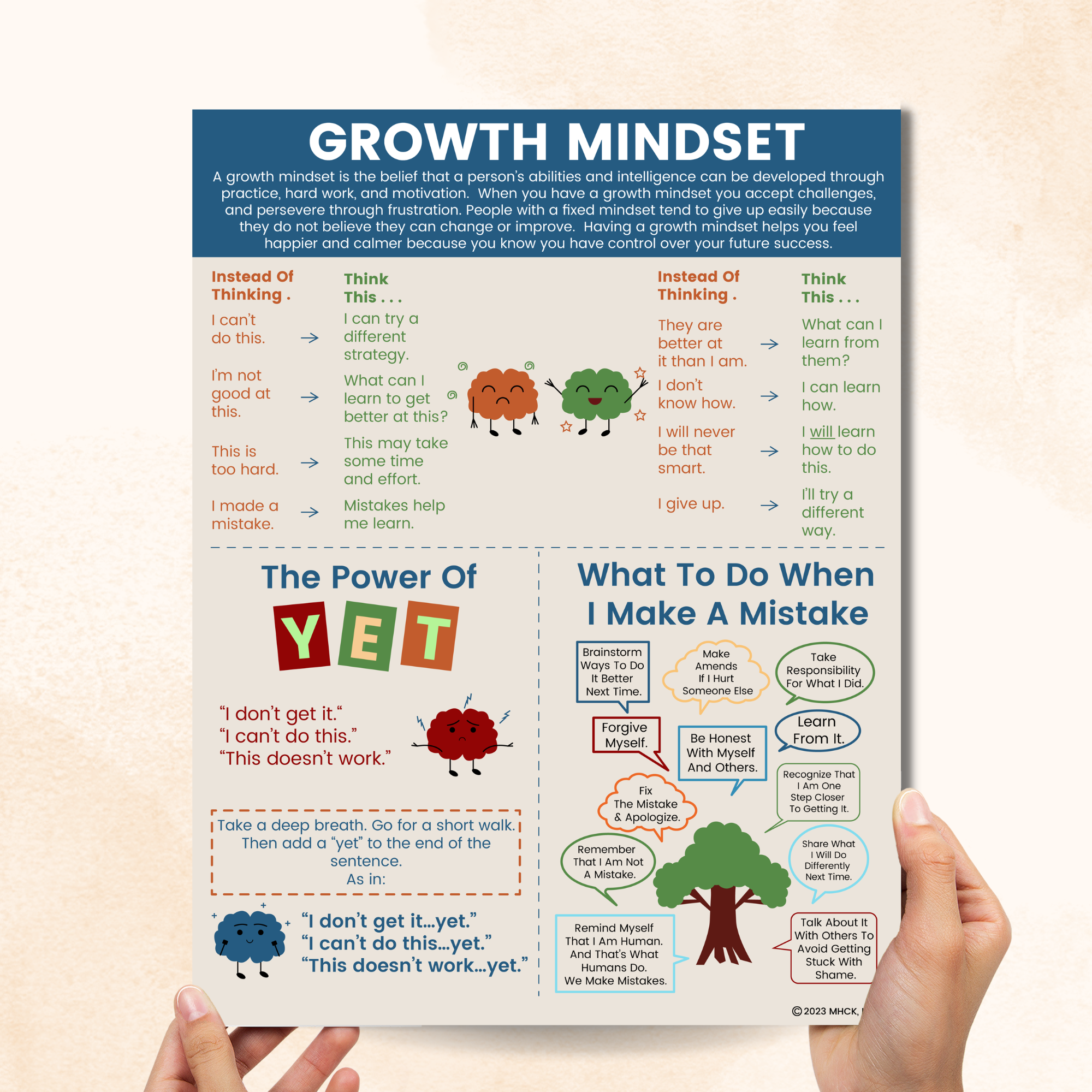|
Key Takeaways:
- Developing a growth mindset can make kids and teens more resilient in the face of struggles and stress.
- Growth mindset posters teach children about perseverance, persistence, grit, and determination, among other things.
- You can supplement growth mindset posters with additional tools, such as growth mindset books and quotes.
|
A growth mindset refers to how children can improve their intelligence and skills over time to succeed. It encourages them to learn new things, even when they’re older. Equipping your child with growth mindset posters reminds them that mistakes are just an obstacle and that they can pave a path toward improvement.
No matter how successful and intelligent someone may be, there is always room for improvement. Discover 15 of our favorite growth mindset posters for kids and teens.
15 Growth Mindset Posters for Kids & Teens
You can use growth mindset posters anywhere—from home to inside the classroom—to remind your child that learning happens daily. Here is our collection of growth mindset posters.
1. Growth Mindset Poster

Our fundamental growth mindset poster outlines what it means to persist during difficult times and helps young children reframe negative thoughts. For instance, if a child believes they can’t achieve a specific goal, our growth mindset poster encourages them to replace this thought with a different strategy.
Download the poster here
2. Growth Mindset vs. Fixed Mindset Poster

People with fixed mindsets believe their skills and talents are inherent, while growth mindsets encourage them to keep trying [*]. Our growth mindset vs. fixed mindset poster encourages children not to fear failure but instead see it as an opportunity to improve. Children with a growth mindset don’t give up easily and avoid labeling themselves.
Download the poster here
3. Goal Setting Tips for Success Poster

Goal-setting encourages children to be responsible for their choices and take ownership of their progress. Using our goal-setting tips for success can inspire young people and give them a sense of achievement when they succeed. It encourages children to apply SMART goals, create a timeline, and track their progress.
Download the poster here
4. Success Iceberg Poster

Sometimes, people only see the tip of the iceberg when they succeed—they don’t see the failures, mistakes, and struggles it took to get there. Our success iceberg poster reminds children that success doesn’t happen easily or without setbacks. It encourages individuals to reflect on their qualities and habits to pave a clearer way to success.
Download the poster here
5. Ways to Achieve Success Poster

Achieving success demands time, effort, and creative outlets. By exploring the different ways to achieve success with your child, they can better understand their strengths and what motivates them.
Our list outlines 101 suggestions such as asking questions about interesting topics, staying true to one’s values, spending time with positive and successful people, and getting out of one’s comfort zone.
Download poster here
6. Tips to Improve Self-Motivation Poster

Children, especially preteens or older teenagers, may lack self-motivation due to school expectations, a desire to be with friends, or occasional laziness. Reviewing tips to improve self-motivation can help children take simple steps to improve a specific habit or achieve a goal.
For instance, they might surround themselves with motivation, reward themselves for accomplishments, and eliminate distractions when they’re trying to focus. You can also use our growth mindset quotes to practice self-motivation throughout the day.
Download the poster here
7. How to Develop Self-Discipline Poster

It takes a lot of self-discipline to achieve a personal goal, and staying focused isn’t always easy. Learning how to develop self-discipline allows children to have more control over their thoughts, feelings, and actions and overcome obstacles like procrastination.
Our poster provides tips on using productive self-talk to motivate yourself, practicing healthy habits like exercising, setting a sleeping schedule, and managing stress through self-care.
Download the poster here
8. Grit, Determination, and Diligence Poster

Reaching one’s full potential requires grit, determination, and diligence. These traits are part of the fundamental characteristics of a growth mindset. Sometimes, we must push ourselves to succeed, even when things are uncomfortable or scary.
Some ways to develop determination include resting and recharging when tired, turning actions into good habits, and never giving up, even when times are tough.
Download the poster here
9. Overcoming Failure Poster

Overcoming failure is an essential step in the journey to success. If your child has made a mistake that led to failure, they must know they aren’t alone.
Use our poster to remind your child that failure is normal and there is always room for improvement. Remind them that mistakes are there to impart life lessons and help them differentiate between right and wrong.
Download the poster here
10. SMART Goals Poster

SMART goals are specific, measurable, achievable, relevant, and time-bound goals that help kids and teens make greater progress when honing their skills and nurturing talents. This goal-setting mechanism ensures children make highly focused efforts and have ways to track their progress.
Our poster provides additional tips on what to do and what to avoid when setting SMART goals, such as focusing on one goal at a time and doing their best not to rush the process.
Download the poster here
11. All About Taking Risks for Success Poster

All successes require some level of risk. When children fear failure, they may shy away from potentially precarious situations. However, taking calculated risks is often necessary to achieve one’s goals.
Our poster shares what there is to know about taking risks for success, such as developing an action-oriented personality and trusting one’s gut.
Download the poster here
12. Power of Yet Poster

Kids and teens underestimate the power of yet when they feel incapable of something. Instead of saying, “I can’t do this,” the power of yet encourages children to remind themselves, “I can’t do this… yet!”
This power of yet poster reminds kids that success is a journey and mastering skills doesn’t happen overnight.
Download the poster here
13. All About Persistence Poster

When we fail, we try again—but sometimes, getting back up can feel overwhelming or even impossible. Teaching your child all about persistence imparts upon them the value of trying harder, thinking positively, and developing an action plan.
Other tips for persisting include seeking advice from trusted adults, learning how to start over, and taking breaks when things feel like they’re too much.
Download the poster here
14. All About Being Proactive, Self-Directed Poster

While good things come to those who wait, it’s important to pursue goals actively. When kids are proactive and self-directed, they behave in ways that prevent problems from happening and take complete responsibility for their progress.
We encourage kids and teens to use proactive language, as it reminds them that they are in control.
Download the poster here
15. All About Leadership Skills Poster

Some kids are born leaders, but others develop this skill later. When children and teens learn to be good leaders, they become more accountable for their actions, make hard real-life decisions, and empathize with others.
Our poster about leadership skills provides tips for becoming a successful leader, such as being honest, treating others respectfully, and maintaining a positive attitude.
Individuals can learn more about developing a winning mindset by reading age-appropriate books about growth mindsets.
Download the poster here
Summary
The occasional mistake or failure is inevitable, and kids and teens with a growth mindset will be more likely to challenge themselves, stay resilient, and become creative problem-solvers.
Practicing growth mindset activities, such as goal-setting, brainstorming, and creating a self-awareness checklist, encourages kids to embrace challenges, learn from feedback, and persevere in the face of setbacks.
Explore our growth mindset posters collection to review all of our growth mindset resources in one.
Sources:
- Haimovitz K, Dweck CS. “The Origins of Children’s Growth and Fixed Mindsets: New Research and a New Proposal.” Child Development, 2017



































































